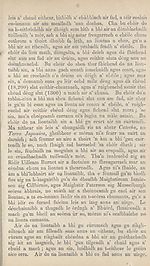Books and other items printed in Gaelic from 1841 to 1870 > Seol air an glacar agus an gréidhear an sgadan, agus air an gréidhear an trosg, an langa, a traille, agus am falmair
(16) Page 6
Download files
Complete book:
Individual page:
Thumbnail gallery: Grid view | List view

6
tered by the first boat, the whole fleet are likely to be
equally disappointed. Under any circumstances, the boats
should not crowd too much together, but leave sufficient
intervals of room between each other, so that the trains of
net may be shot without any risk of one train interfering ‘a
with or getting entangled with another. A good and effi¬
cient net ought to be 50 yards long on the back rope, by
14 yards deep; and a good and proper train should contain
26 of these nets, hanging in succession from the back rope,
thus containing altogether 18,200 square yards, stretching
over a line of sea of 1300 yards in length. The swing or
net rope should be about 120 yards long, so that the
whole length of nets and line may stretch along 1420 yards
of sea, or about four-fifths of a mile. These nets should
be properly tanned; and if done with the drug called
catechu, or terra japonica, it will be found much better
than oak-bark ; but care must be taken when using it,
not to overdo the process, otherwise the meshes may be¬
come contracted and too much hardened. Sir William
Burnet’s patent likewise has been found extremely good
for the preservation of nets. And farther, whilst on the
subject of nets, it may be well that fishermen should know
that Messrs. Jamieson of Kilbirnie, and Mr. Paterson at
Musselburgh, have manufactured a particular description
of small twine for nets, which, whilst it is equally strong
with the common net, is much less easily seen by the fish
in the w'ater, and has consequently been found by expe¬
riments made by orders of the Board, to be much more
successful than the ordinary nets.
The train of nets having been carefully and regularly
coiled up in the boat, should, on arrival at the fishing
ground, be gradually shot out with equal care and atten¬
tion, and then the boat lies with the train attached to it.
After the train shall have remained in the water for
such a length of time as may appear necessary for al-
tered by the first boat, the whole fleet are likely to be
equally disappointed. Under any circumstances, the boats
should not crowd too much together, but leave sufficient
intervals of room between each other, so that the trains of
net may be shot without any risk of one train interfering ‘a
with or getting entangled with another. A good and effi¬
cient net ought to be 50 yards long on the back rope, by
14 yards deep; and a good and proper train should contain
26 of these nets, hanging in succession from the back rope,
thus containing altogether 18,200 square yards, stretching
over a line of sea of 1300 yards in length. The swing or
net rope should be about 120 yards long, so that the
whole length of nets and line may stretch along 1420 yards
of sea, or about four-fifths of a mile. These nets should
be properly tanned; and if done with the drug called
catechu, or terra japonica, it will be found much better
than oak-bark ; but care must be taken when using it,
not to overdo the process, otherwise the meshes may be¬
come contracted and too much hardened. Sir William
Burnet’s patent likewise has been found extremely good
for the preservation of nets. And farther, whilst on the
subject of nets, it may be well that fishermen should know
that Messrs. Jamieson of Kilbirnie, and Mr. Paterson at
Musselburgh, have manufactured a particular description
of small twine for nets, which, whilst it is equally strong
with the common net, is much less easily seen by the fish
in the w'ater, and has consequently been found by expe¬
riments made by orders of the Board, to be much more
successful than the ordinary nets.
The train of nets having been carefully and regularly
coiled up in the boat, should, on arrival at the fishing
ground, be gradually shot out with equal care and atten¬
tion, and then the boat lies with the train attached to it.
After the train shall have remained in the water for
such a length of time as may appear necessary for al-
Set display mode to:
![]() Universal Viewer |
Universal Viewer | ![]() Mirador |
Large image | Transcription
Mirador |
Large image | Transcription
Images and transcriptions on this page, including medium image downloads, may be used under the Creative Commons Attribution 4.0 International Licence unless otherwise stated. ![]()
| Permanent URL | https://digital.nls.uk/109612114 |
|---|
| Description | Out-of-copyright books printed in Gaelic between 1631 and 1900. Also some pamphlets and chapbooks. Includes poetry and songs, religious books such as catechisms and hymns, and different editions of the Bible and the Psalms. Also includes the second book ever published in Gaelic in 1631. |
|---|

